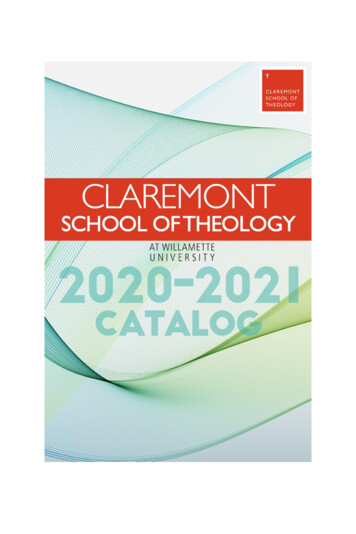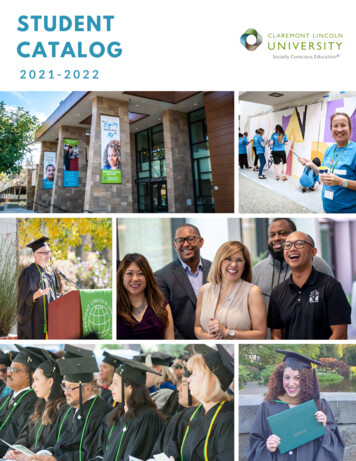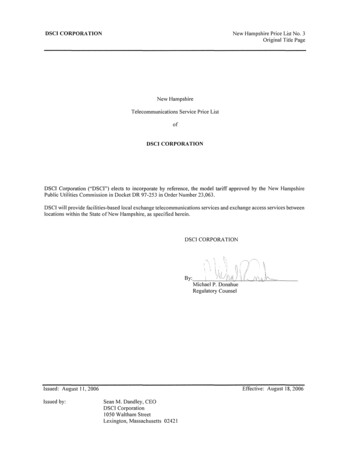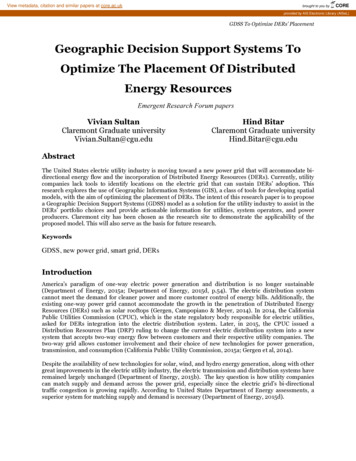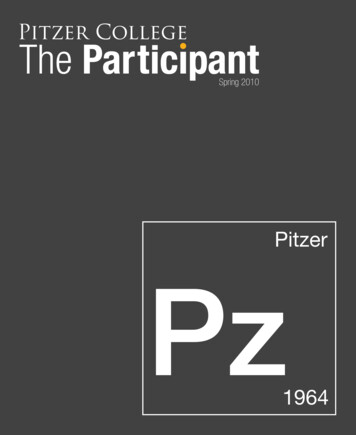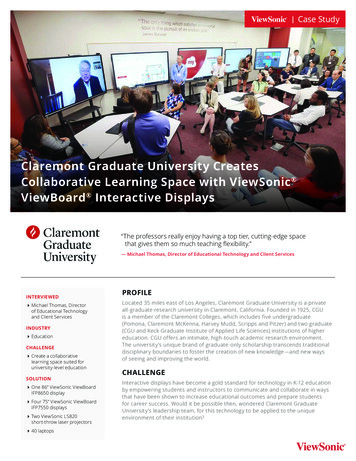
Transcription
Case StudyClaremont Graduate University CreatesCollaborative Learning Space with ViewSonic ViewBoard Interactive Displays“The professors really enjoy having a top tier, cutting-edge spacethat gives them so much teaching flexibility.”— Michael Thomas, Director of Educational Technology and Client ServicesINTERVIEWED Michael Thomas, Directorof Educational Technologyand Client ServicesINDUSTRY EducationCHALLENGE Create a collaborativelearning space suited foruniversity-level educationSOLUTION One 86” ViewSonic ViewBoardIFP8650 display Four 75” ViewSonic ViewBoardIFP7550 displays Two ViewSonic LS820short-throw laser projectors 40 laptopsPROFILELocated 35 miles east of Los Angeles, Claremont Graduate University is a privateall-graduate research university in Claremont, California. Founded in 1925, CGUis a member of the Claremont Colleges, which includes five undergraduate(Pomona, Claremont McKenna, Harvey Mudd, Scripps and Pitzer) and two graduate(CGU and Keck Graduate Institute of Applied Life Sciences) institutions of highereducation. CGU offers an intimate, high-touch academic research environment.The university’s unique brand of graduate-only scholarship transcends traditionaldisciplinary boundaries to foster the creation of new knowledge—and new waysof seeing and improving the world.CHALLENGEInteractive displays have become a gold standard for technology in K-12 educationby empowering students and instructors to communicate and collaborate in waysthat have been shown to increase educational outcomes and prepare studentsfor career success. Would it be possible then, wondered Claremont GraduateUniversity’s leadership team, for this technology to be applied to the uniqueenvironment of their institution?
Claremont Graduate University CreatesCollaborative Learning Space with ViewSonic ViewBoard Interactive DisplaysRESULTS Huddle spaces provide efficientstations for group work. Large screens increase visibilitythroughout the classroom. Modular furniture andcart-mounted displays offereasy flexibility. Exceeded the expectationsof faculty, IT staff and CGUleadership team. In high demand by faculty;was fully booked prior toCOVID closures. Faculty have savedtime and increasedstudent collaboration. Provides collaborative space forboard meetings, special eventsand faculty/staff training.What started off as a thought experiment quickly became reality when CGUboard members, Trustee Wen Chang and university president Len Jessup metwith ViewSonic leadership to discuss different possibilities. The membersgreenlit a project that would eventually become known as the AdvancedLearning Environment (ALE), a room outfitted with several ViewSonic ViewBoard interactive displays and short-throw laser projectors, along withenough laptops to accommodate every student. If it worked as anticipated,it would become the prototype for future classrooms.But before the ALE could change the way CGU approached technology,it first needed to pass muster with the IT team that would be responsiblefor implementation. Associate Vice President of Finance and Administration/Technology Services and Information Systems Manoj Chitre admits to beingskeptical at first.“ViewBoard displays have great capabilities and deliver a terrific, immersiveclassroom experience that’s great for K-12 education,” said Chitre. “As agraduate-only institution it wasn’t immediately apparent how our faculty woulduse the devices. I wondered, how applicable would they be to our class settings?”Michael Thomas, Director of Educational Technology and Client Services, was of asimilar mindset.“These tools, the ViewBoard displays and myViewBoard software, werespecifically designed for K-12,” said Thomas. “We were assured by the ViewSonicteam that the software would translate well to pedagogy for adults and that itwould be regularly updated for this use.”With all the relevant stakeholders onboard with the project, the IT and leadershipteams went to work.SOLUTIONThe ALE was envisioned as an interactive space where teachers could have theflexibility to expand their teaching methods and foster creativity and collaborationindividually and in groups.ViewSonic worked with the CGU team to determine the best technology to bringthis collaborative vision to life, ultimately selecting five interactive displays – an86” ViewSonic ViewBoard IFP8650 to serve as the “teaching display” and four 75”ViewSonic ViewBoard IFP7550 displays for use by students – all featuring 4K UltraHD resolution and immersive 20-point touchscreens. For flexibility, each displaywas mounted on a cart to enable teachers to move them around the room asdesired. Two ViewSonic LS820 short-throw laser projectors and 40 laptops roundedout the room.“We knew that for this room to embody our vision it needed to be highly versatile,”said Thomas. “My philosophy is that technology alone isn’t always the solutionand to achieve our goals every element of the room needed to contribute to themodularity. To achieve this, CGU leadership ultimately invested in a completeremodel of the space.”
Claremont Graduate University CreatesCollaborative Learning Space with ViewSonic ViewBoard Interactive DisplaysIFP50 4K Ultra HD resolution display 20-point immersive touchscreen myViewBoard annotation software ViewBoard Cast streaming softwareLS820 Ultra-short throw projector 1080p resolution Color accuracy delivers anamazing cinema-like experience Utilizing the latest laserlight technologyWith financial backing from the University’s board, the team gave the room amodern makeover to make it more accessible for students. Whereas before therewas a typical 800 sq. ft. lab with rows of tables and chairs, there now stood avibrant, cutting-edge technology center. An electrified glass wall provided a senseof openness but also doubled as a privacy filter by being opaque at the push of abutton. Window blinds (which normally took minutes to close) became motorizedand could be remotely raised and lowered as a group. A browser-based systemprovided hassle-free room scheduling and cut down on many of the conflicts thatcame with booking a regular meeting space.“The old room was very static. This one is modular and modern,” said Thomas. “Thefurniture is modular and easy to reconfigure. The ViewBoard displays are on rollingcarts. Everything can be easily changed up to accommodate different needs.”The CGU IT team completed the installation during the summer of 2019. InSeptember, the Advanced Learning Environment was officially open for use.With help from ViewSonic, the IT team laid the groundwork for a successful launch.“ViewSonic helped train my team members, who became trainers for the faculty,”said Thomas. “We also created documentation on how to use the tools andsoftware in the room, including recommendations on how to use these resourcesfor different teaching modalities.”RESULTSThe ALE quickly became one of the most popular spots on campus, with fivemonths of increasing use before the university shut down in March of 2020to slow the spread of COVID-19.“Pre-pandemic the ALE was being used daily by faculty across the campus,” saidThomas. “The Statistics professors were the first to use it extensively, but soon itwas being used for every type of class as well as for board meetings, special eventsand training faculty and staff from our sister schools.”It was so in-demand, says Thomas, that they regularly had to turn people away.“This room provides the faculty with capabilities they didn’t have in the past,and it’s changing the way they teach,” he said. “Some use all the displays at once,for upgraded one-to-many teaching. For example, this approach is good for classesthat use the Socratic method, and it adds visibility for vision-impaired students.Many use the displays separately for breakouts and group work, then have thestudents share their work onto the large screens using myViewBoard software.In Professor Brian Hilton’s Geographic Information Systems (GIS) class, ViewSonicViewBoard displays have particularly been effective at saving time for both himselfand his students. Consider this “then” versus “now” snapshot of group work inHilton’s classes with and without the large screen huddle spaces.“Before I had these resources to use, groups of students would share a singlelaptop to create the assigned GIS maps or apps. To demonstrate their work,they had to come to the front of the room, login to their account and find thecorrect content – all before they could begin discussing it, all of which took time,”said Hilton. “Now each group works at a large ViewSonic ViewBoard display,which has many benefits.”
Claremont Graduate University CreatesCollaborative Learning Space with ViewSonic ViewBoard Interactive Displays“First of all, it gets them up and moving, getting into groups around their display –a good outcome for evening classes where almost everyone is coming from work atthe end of a long day. They then proceed as before with the exercise, but since thescreen is large, they have the ability to work together rather than just watch oneperson manipulate the application. Then, when it’s time for their demonstration,we just move between groups – it’s much more efficient.”Hilton also talked about another unanticipated bonus, “The groups at eachdisplay can easily see what the others are doing, which creates some usefulfriendly competition.”The results lived up to the high expectations that the CGU leadership had forthe room. What the team couldn’t have anticipated was how useful the ALE wouldbecome in the wake of the coronavirus pandemic.“This room has proved valuable in so many ways we didn’t imagine,” said Chitre.“For one thing, it was an ideal environment for training faculty in online learningtools and techniques before going home in March.”“For another,” said Chitre, “ViewBoard displays have proven invaluable in facilitatingremote teaching in new ways at the outset of the 2020-2021 school year, with thecampus closed and the university offering online flexible learning.“Some faculty can’t or don’t want to teach from home,” he said. “We’ve been ableto bring them on campus and enable them to use the big screens to connect withremote students. They can talk to them easily and present though the ViewBoarddisplays. It’s really been a blessing for them.”The combination of Zoom plus the ViewSonic ViewBoard displays has beentremendous, added Thomas.“These tools together have been a huge win this fall for the faculty teaching fromcampus,” he said. “They wanted to be in a classroom to teach but many foundit awkward lecturing on Zoom to an empty room. When we set them up on theViewBoard displays with webcams and they were able to see a large gallery of theirstudents’ faces and have bidirectional conversations -- definitely a more enjoyableteaching and learning experience.”
Claremont Graduate University CreatesCollaborative Learning Space with ViewSonic ViewBoard Interactive DisplaysTo maximize this benefit, the ViewBoard displays were moved toindividual classrooms.According to Thomas, whether it was late 2019, during the transition toremote learning, or in its current distributed locations, feedback has been“overwhelmingly fantastic.”“The faculty really enjoy the modularity of the ALE and the touchscreen aspectof the displays has been one of the biggest wins,” he said. “The screens areabsolutely gorgeous and the touchscreen capabilities are outstanding. We’ve hadnothing but positive feedback about the displays.”All in all (pandemic notwithstanding), the faculty’s expectations wereoverwhelmingly met, says Thomas.“The professors really enjoy having a top tier, cutting-edge space that gives them somuch teaching flexibility,” he said. “We’re looking forward to extending the conceptand are working with ViewSonic to acquire more ViewBoard displays.”The IT team has also been offering demos of the ALE for CGU’s sister colleges.“Scripps just bought three and CMC is also in the process acquiring some ViewSonicViewBoards,” he said. “I’m looking forward to getting more – a lot more.”This document contains forward-looking statements that reflect the company’s expectations with regard to upcoming events and product offers. The actual eventsand product offer may significantly differ from those referred to in this document. Specifications and availability are subject to change without notice. Corporate namesand brand mentioned in this document are property of their respective companies. Copyright 2021 ViewSonic Corporation. All rights reserved. [20VWB EDU1474]
Located 35 miles east of Los Angeles, Claremont Graduate University is a private . all-graduate research university in Claremont, California. Founded in 1925, CGU . is a member of the Claremont Colleges, which includes five undergraduate (Pomona, Claremont McKenna, Harvey Mudd, Scripps and Pitzer) and two graduate (CGU and Keck Graduate .

